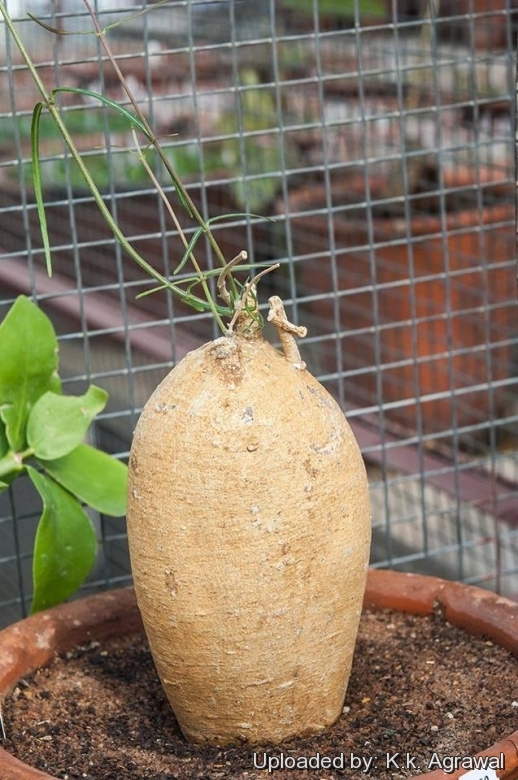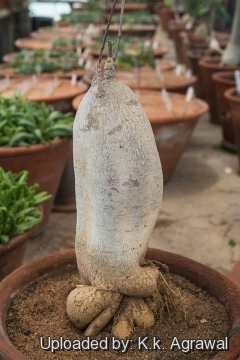
Fockea comaru Photo by: K.k. Agrawal
Origin and Habitat: Republic of South Africa, Eastern and Western Cape.
Habitat: Fockea comaru is very common and it is found on hillsides both amongst rocks where it has short, prostrate stems, and in sandy areas where it has much taller branches. It grows in the same general area, togheter with Ceropegia africanaSN|26946]]SN|26946]], Haworthia margaritiferaSN|17057]]SN|26159]], Haworthia herbaceaSN|26159]]SN|17057]], Adromischus filicaulisSN|27682]]SN|27682]] and various creeping Senecios. Fockea comaruSN|28006]]SN|28006]] is the only species of Fockea that is grows in winter rainfall regions.
Synonyms:
See all synonyms of Fockea comaru
back
Accepted name in llifle Database:Fockea comaru (E.Mey.) N.E.Br.Fl. Cap. (Harvey) 4(1): 781 1908Synonymy: 2
back
Common Names include:
ENGLISH: Kombru
AFRIKAANS (Afrikaans): Kambro, Klipkambro, Sandkambro, Kamaroo, Kambro's, Kombroo, Kombrua
Description: Fockea comaru is a caudiciform subshrub bearing large underground stem tubers. The tuber is made up of spongy, water holding tissue that helps it surive periods of drought. It also has a rhizomatous habit and the stems can spread underground some distance from the tuber before emerging from the soil. The flowers are greyish to brownish green.
Root tuber: Mostly underground, turnip-shaped or irregularly shaped. 10 - 25 cm in diameter.
Stems (branches): The annual shoots which appear at the beginning of winter are erect to decumbent,, rather than climbing,10-30 cm, 2-5 mm in diameter, basally becoming woody, young pubescent.
Leaves: More or less sessile, linear-subulate, 20-30 mm long, 1-2 mm broad, green to bluish
green margins revolute (rolled), delicately pubescent
Inflorescence: Almost sessile, 2- to 6-flowered. Pedicels 1 - 2.5 mm long, pubescent.
Flowers: Sepals narrowly lanceolate, c. 2 mm, pubescent. Corolla green-yellow, green-brown to brown, outside pubescent, inside mostly glabrous. Corolla tube campanulate. 3 - 4 mm long. Corolla lobes linear, 5-10 long c 1 mm broad. Corona white. Corona tube 4.5 - 5.5 mm long, central appendage of the outer coronal lobes reflexed, 1.5-2 mm long, lanceolate. Inner coronal lobes hardly 1 mm long.
Related species: It is most closely related to Fockea angustifolia and perhaps only representing the karroid ecotype within this complex.
Bibliography: Major references and further lectures
1) Focke Albers, Ulrich Meve “Illustrated Handbook of Succulent Plants: Asclepiadaceae” Volume 4 Springer, 2002
2) Bruyns, P.V. & Klak, C., “A systematic study of the Old World genus Fockea (Apocynaceae-Asclepioidese).” Annals of the Missouri Botanical Garden 93(4): 535-564 2006
3) Albers, F. & Meve, U. (Editors), “Illustrated handbook of succulent plants. Asclepiadaceae.” Springer, Berlin, Heidelberg, Germany. 2002.
4) Veld & Flora, Volumes 69-71 Botanical Society of South Africa, 1983
 Fockea comaru Photo by: K.k. Agrawal
Fockea comaru Photo by: K.k. AgrawalSend a photo of this plant.The gallery now contains thousands of pictures, however it is possible to do even more. We are, of course, seeking photos of species not yet shown in the gallery but not only that, we are also looking for better pictures than those already present.
Read More... Cultivation and Propagation: Fockea comaruSN|28006]]SN|28006]] is of easy cultivation and hardy. Although it shows decreased activity in the summer period, it never goes into complete dormancy and always carries some leaves. Conversely it can be deciduous in summer if kept dry. It is a particular favourite of caudiciform plant enthusiasts.
Growth rate: Plants grow slowly and caudex take many years to enlarge.
Watering: The plant will take regular water and fertilizer in all year round. However, that species seems to hate being wet for any extended period and rot easily especially in winter if overwatered. In winter keep on the dry side and water only enough to keep the tuber from shrivelling.
Soil: It grows well in most soils, and only requires very fast drainage.
Frost tolerance: Due to its African origin it cannot tolerate freezing temperature but should be able to handle 7 degrees Celsius very easily. Plants grown outdoors may endure relatively wet, cold rainy winters. It prefers sun or light shade, but the tuber should stay constantly in the shade.
Disease and pests: The fockeas are pest free outdoors, but may attract whiteflies if kept in humid greenhouse environments, and some kind of control might be needed. The plant are also attractive to mealy bugs and the aphid occasionally feeds on young stems.
Rot: Rot it is only a minor problem with Fockea if the plants are watered and “aired” correctly. If they are not, fungicides won't help all that much. It is very unlikely to lose this plant from root rot from excessive water. Reliable as a permanent collector's plant.
Traditional uses:
Propagation and planting: Fockea comaruSN|28006]]SN|28006]] is propagated through seeds and stem cuttings.
Food uses: In south Africa the flesh of the tubers is eaten raw, but tubers are very difficult for an inexperienced person to find because most of the plant is below the ground. [We do not suggest plants for consumption!]












